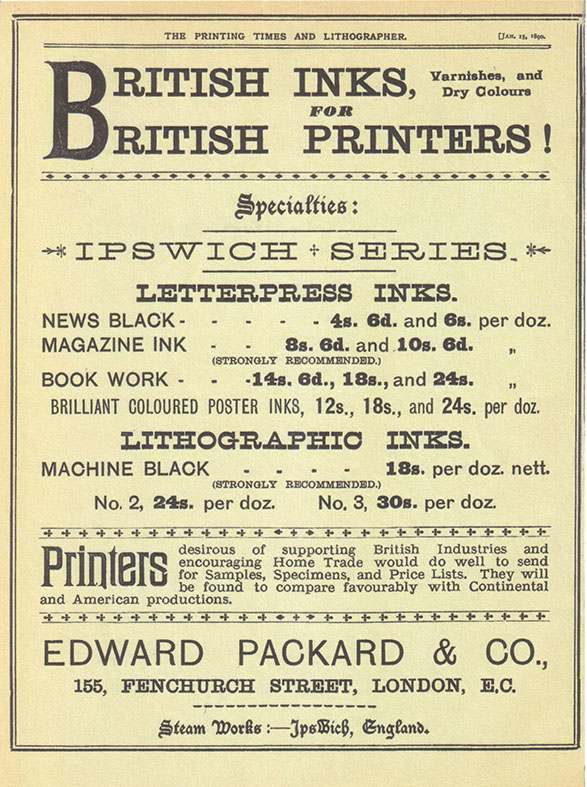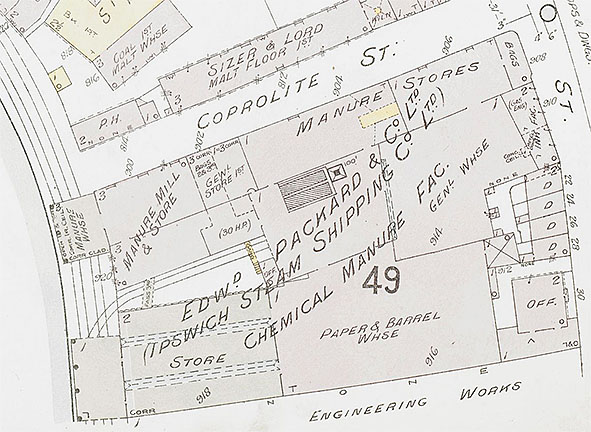- Screen Colours:
- Normal
- Black & Yellow
I read with interest the account of Copperas Reach and its use in the creation of printer’s ink in the January Newsletter (Issue 232). I had recently been reading Tony Copsey’s biographical directory, Ipswich Book Trades (2011)* as it mentions Edward Packard and Co.’s Ipswich Series of inks. So I decided to investigate a little bit further. Edward Packard senior (1819-1899) had qualified as a chemist apprenticed to Francis Cupiss, who not only provided horse medicines but also established a letterpress in Diss in 1830. In fact, Cupiss was still in business until 2022 when the owner retired. The original Columbian Eagle Press dating from the 1830s was still in operation until the end.
Fast forward fifty years to September, 1889 and a notice appeared in the trade journal The Printing Times and Lithographer (PT&L) that Edward Packard and Co. had ‘commenced the manufacture of printing-inks and varnishes, on an extensive scale for exportation’. Whether Edward Packard Senior had a hand in this is hard to say. The day-to-day management of the firm was handed over to his sons: Edward Packard Junior and Henry Wood Packard around this time. Perhaps more pertinent to this new initiative are the reports of a fire in March 1889 in which the businesses premises on Ipswich Dock – alongside Coprolite Street – were entirely destroyed. Edward Packard and Co. had premises in Ipswich and at 155 Fenchurch Street, London. The new business was undertaken by the newly appointed Mr C.H. Midgley, who had previous experience in the print supplies trade. At a time when the fertiliser trade was facing stiff competition from abroad, particularly the USA, Midgley was a strong advocate of ‘British Ink for British Printers’ (see November 1889 issue of PT&L). The full page advert shown here appeared regularly in the PT&L in 1890.

By April 1890 they had established an office at 95 Bath Street Glasgow, where they proposed to keep stocks of their printing products under the management of William V. Graham. However by September of that year Packards had re-located their London office to 17 Lawrence Lane, conveniently near the Great Eastern Railways Parcel depot. But more revealing is that Mr Midgley announced that as of 11 September he had severed all connection with them. He stated he intended to set up in business on his own account selling of print machinery and sundries. He also offered his services as an agent for “the sale and purchase of businesses, and the negotiation of partnerships in connection with the printing trade”.
Bernard O’Connor has written about the problems of the coprolite-based fertiliser trade in Suffolk (The Suffolk Fossil Diggings 2009) and quotes an account of the 1889 fire. However he doesn’t mention this attempt to branch out into manufacturing printing ink – which as it lasted barely a year is hardly surprising. Their involvement in shipping – which had started many years earlier under Edward Packard senior – is treated more fully.

Charles E. Goad Ltd make no mention of printing ink facilities in the detailed plan of Packard’s dockside premises, Ipswich. This was produced for insurance purposes in 1909 and the premises are identified as belonging to Edward Packard and Co. Ltd. – and the Ipswich Steam Shipping Company Ltd. It principally refers to the processing and storing of chemical manure. Nevertheless, I hope this brief account gives an idea of how an Ipswich business set out to explore adapting their product range when their principal trading market was no longer viable.
For The Printing Times and Lithographer (1875-1891)
see https://en.wikisource.org/wiki/Portal:Printing_Times_and_Lithographer;
Bernard O’Connor has the website http://bernardoconnor.org.uk and his book, The Suffolk Fossil Diggings, (2009) is available in various formats;
Maps of Ipswich by Charles E. Goad Ltd can be downloaded from Wikimedia Commons at https://commons.wikimedia.org/wiki/Category:Goad_fire_insurance_maps_of_Ipswich;
Photographs of the Columbian Eagle Press can be seen on their facebook page:
https://www.facebook.com/CupissLetterpress.
Fabian Tompsett
[N.B.: Packard’s London office is shown on the advertisement, but it’s nice that they are also at ‘Steam Works: – Ipswich, England’ and now we know from the 1909 Goad map that this refers to the Ipswich Steam Shipping Co. Ltd.
*Copsey, Tony. The Ipswich book trades : booksellers, bookbinders, engravers, librarians, music sellers, newsagents, papermakers, printers, publishers, stationers at Ipswich until 1900 : a biographical dictionary. 2011, Ipswich. Distributed by Claude Cox. Can be consulted at Suffolk Record Office, The Hold. – Ed.]